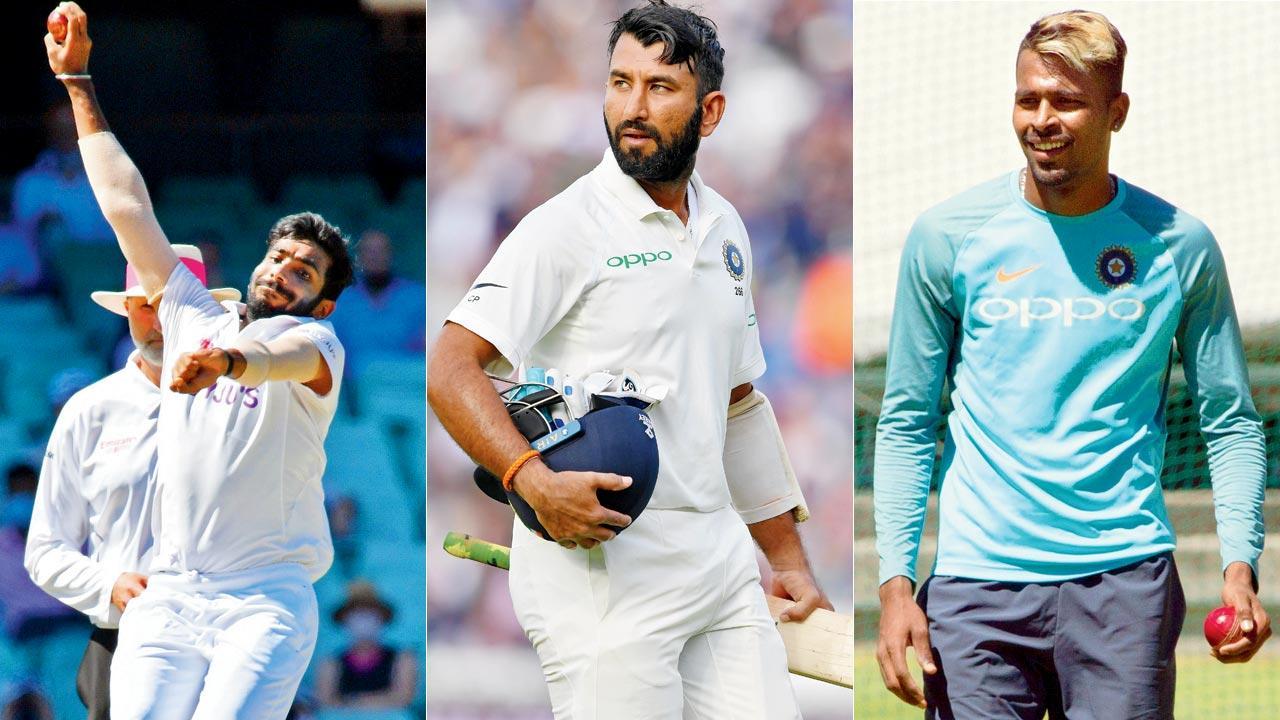Looking at the number of players Gujarat is churning out, it will soon become a powerhouse in providing cricketers to the Indian team; officials point to mutual work as an important factor

Team India and Gujarat pacer Jasprit Bumrah. Pic/Getty Images; Cheteshwar Pujara and Hardik Pandya
During the last Test match played at Motera in November 2012, (India v England) Saurashtra’s Cheteshwar Pujara was the lone player from Gujarat in the playing XI.
ADVERTISEMENT
Nine years down the line against the same opponents, three Gujarat players—Pujara, Jasprit Bumrah and Axar Patel—were in the XI, while Hardik Pandya was in the squad. It is perhaps for the first time that four players from the state of Gujarat are part of the Indian Test team.
It should also be noted that Gujarat skipper Priyank Panchal was released from the Indian team as a standby player after the second Test at Chennai. One can count in Ravindra Jadeja as well. He would have been in this group had it not been for his injury.
Meanwhile, Krunal Pandya and Jaydev Unadkat are trying to reclaim their place in the Indian limited-overs teams.
Looking at the number of players Gujarat is churning out, which include cricketers from Baroda Cricket Association (BCA), Saurashtra Cricket Association (SCA) and Gujarat Cricket Association (GCA), it is soon becoming a powerhouse as far as supplying cricketers to the Indian team is concerned.
There are some Indian states where one or more cricket associations are handling the affairs in the area earmarked in their constitution. So what is BCA, SCA and GCA doing right? “As part of our pre-season preparation, we conduct a G1 tournament, which is played between teams from Baroda, Saurashtra and Gujarat. We have one-day, T20 and two-day matches for all age groups. We mutually decide where and when to hold it for our regular players to participate,” former Gujarat Ranji Trophy coach Vijay Patel told mid-day on Thursday.
Test of skills
“It provides good exposure to our players—the regulars as well as—players on the bench. It tests their skills against different players and selectors get to see where their players stand and what the teams lack. It is a tournament all the three associations mutually decide to play whenever there are no BCCI matches scheduled,” SCA president Jaydev Shah said.
Shah, the former Saurashtra captain, felt the boom in infrastructure with Ahmedabad having the world’s largest cricket stadium and Rajkot boasting of a Lord’s-like media centre and practice pitches, have been instrumental in tapping talent. “It’s all process-driven at SCA. The selection is fair and transparent. Ever since I took charge, I have emphasised on playing matches and more matches. Exposure is very vital to players and it is a great tool for learning,” said Shah.
BCA chief executive Shishir Hattangadi; the former Mumbai captain, said the focus on districts has worked wonders for Baroda cricket. “We have several talent programs, matches and facilities now to ensure players don’t have to travel two to three hours to hone their skills. It is all available in their vicinity. We have tried to make facilities more accessible. Also, the systems we have in place ensure no talent goes unnoticed. The focus is very much on unearthing new talent and then grooming them at our excellence centre in Baroda,” said Hattangadi.
Change in attitude
According to Patel, the emphasis on overall development of players has led to a change in attitude. “We have a professional set-up now with specialist coaches,
trainers and analysts. There is a lot of focus now on fitness as it is one of the main criteria to get selected for the Indian team. So, development begins from a young age,” said Patel.
Shah was proud of the fact that the money is channelised well to improve their cricket. “We are not here to handle cricket but to improve cricket. I am glad that cricket is progressing really well in our state,” he concluded.
 Subscribe today by clicking the link and stay updated with the latest news!" Click here!
Subscribe today by clicking the link and stay updated with the latest news!" Click here!






